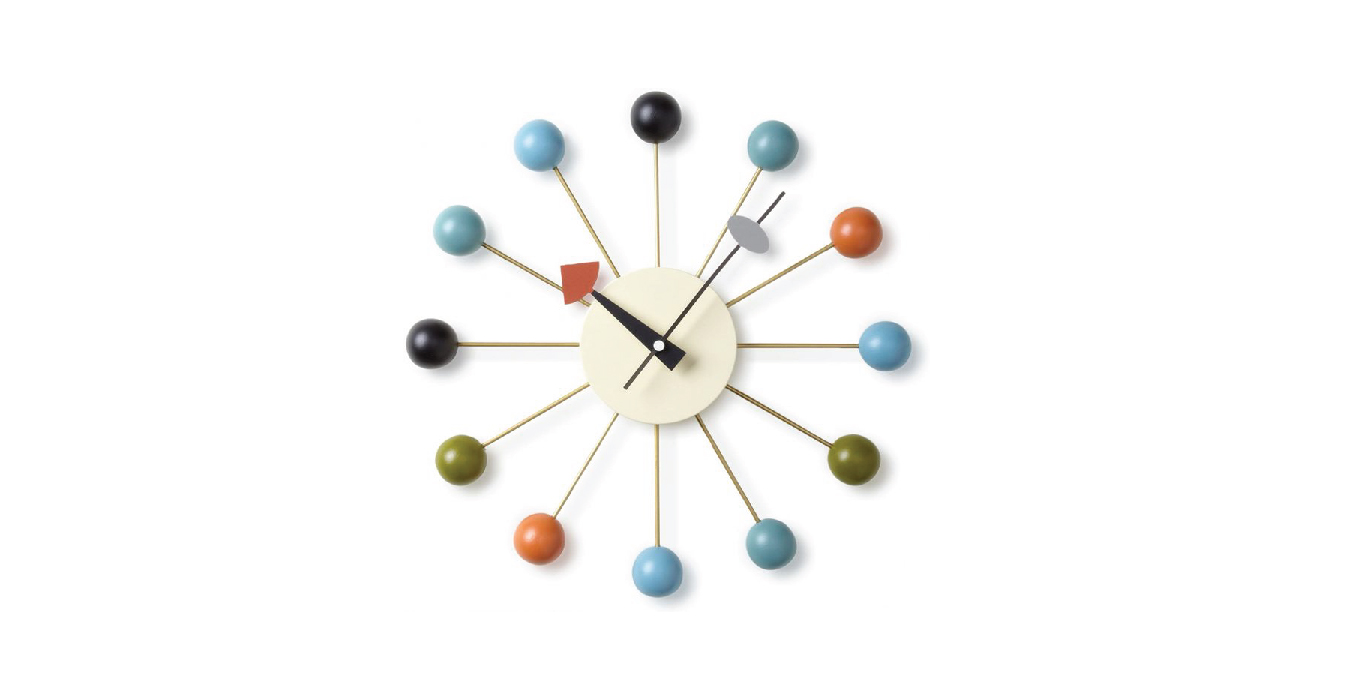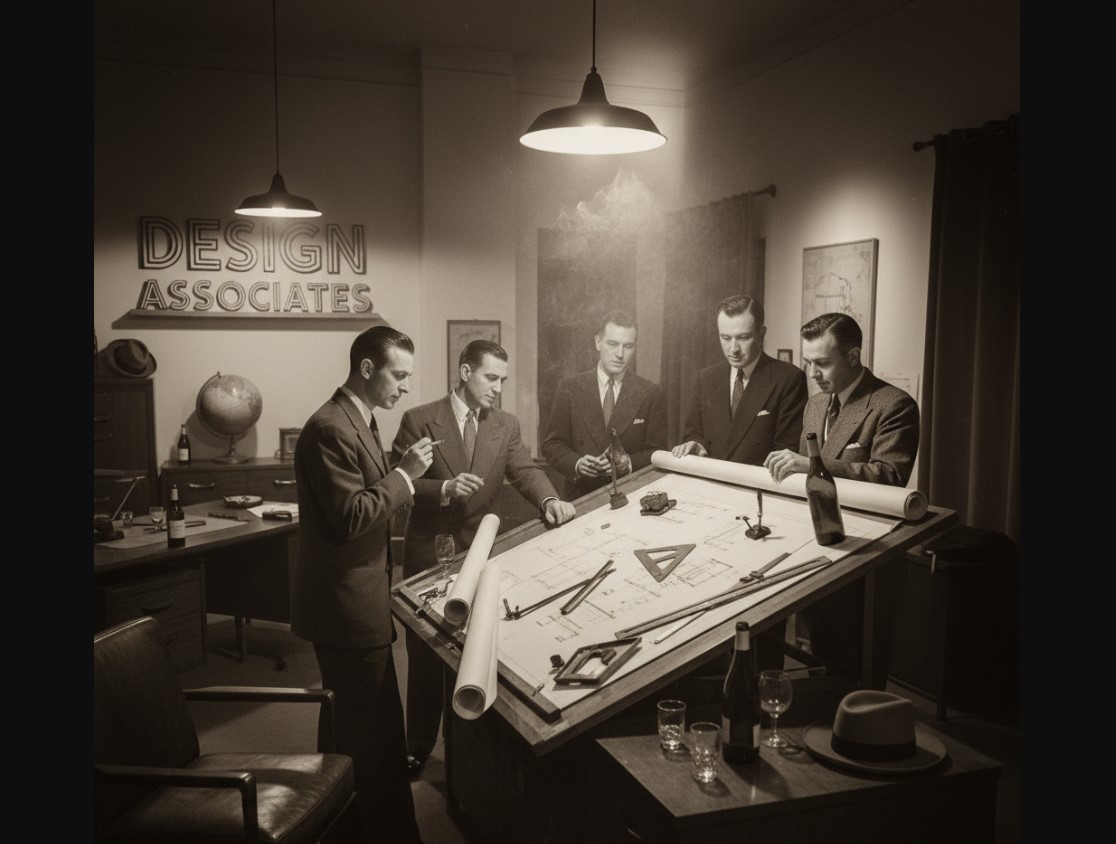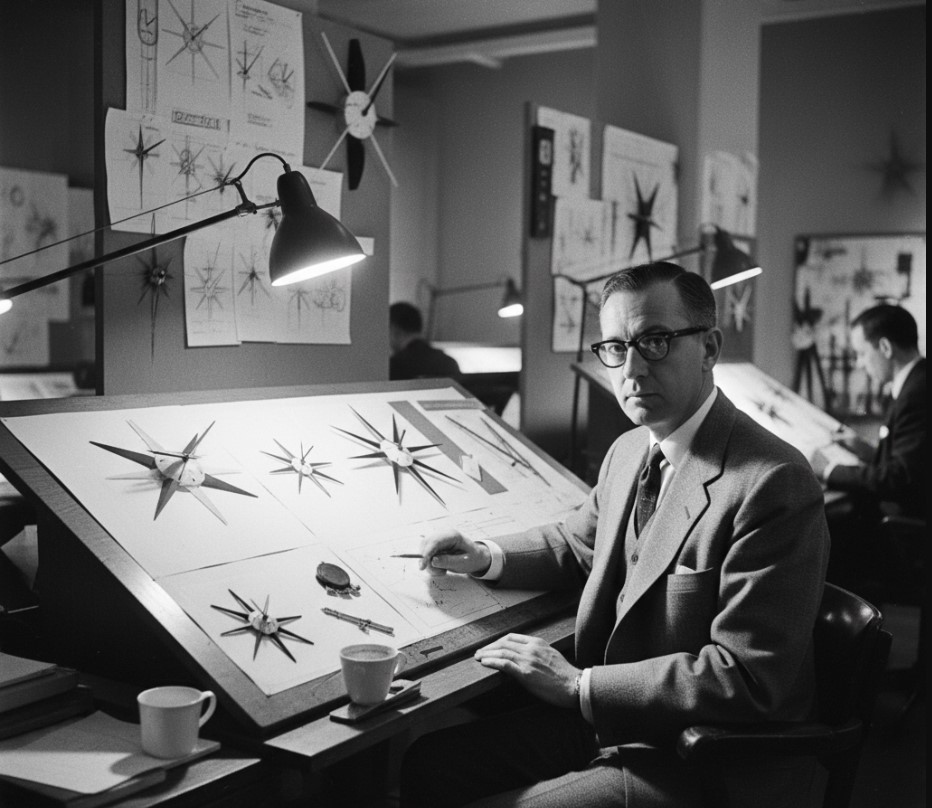George Nelson Clock Designs: Manufacturing and Market Impact

In 1947, George Nelson designed a clock that looked like the solar system exploded in your living room, and Howard Miller mass-produced it. The Ball Clock contained zero traditional clock mechanisms - just metal rods, wooden balls, and a basic quartz movement. It sold as Model 4755 in the original 1949 catalog, available in six color variations.
Nelson had observed something that traditional clock manufacturers missed: people wearing wristwatches no longer needed wall clocks to tell time. The numbers had become decorative noise. His studio removed them entirely, creating timepieces that functioned as sculptural elements rather than precision instruments.
The 1947 Design Session That Changed Wall Clocks

The Ball Clock emerged from an evening at Nelson's New York office where four designers - Nelson, Irving Harper, Buckminster Fuller, and Isamu Noguchi - sketched clock concepts while working through bottles of wine. Nelson recalled the session decades later: "We were all tired, and we'd had a little bit too much to drink - and the next morning I came back, and here was this roll [of drafting paper], and Irving and I looked at it, and somewhere in this roll there was the ball clock."
None of them could definitively say who created the design. Nelson guessed it might have been Noguchi, "because [he] has a genius for doing two stupid things and making something extraordinary out of the combination." The uncertainty never mattered to the market - the Ball Clock became what Nelson described as "a sort of all-time best-seller for Howard [Miller, because] suddenly it was decided by Mrs. America that this was the clock to put in your kitchen."
The design reduced timekeeping to its essential elements: 12 metal spokes radiating from a circular center, each with a threaded end accepting a wooden ball to mark the hour. Two hands terminated in an arrow and oval shape. No numbers. No Roman numerals. No traditional clock face.
Howard Miller Clock Company and Herman Miller's Family Connection
Howard Miller Clock Company originated as the Herman Miller Clock Company division in 1926, founded by D.J. De Pree, who had established Herman Miller furniture manufacturing three years earlier. In 1937, De Pree turned the clock division over to his brother-in-law, Howard Miller, who renamed it after himself rather than his father Herman (the original Herman of Herman Miller).
This family connection meant George Nelson, hired as Herman Miller's design director in 1944, had direct access to Howard Miller Clock Company when he proposed his clock collection in 1947. The companies operated independently but shared family leadership and remained headquartered across the street from each other in Zeeland, Michigan.
Starting in 1947, Howard Miller Clock Company commissioned George Nelson Associates to create their modern clock line. The first collection launched in 1949 with 14 timepieces - wall clocks and compact table clocks. Over the following 35 years, Nelson's studio produced more than 130 different clock models: wall clocks, floor clocks, portable table clocks, and built-in clocks.
Irving Harper's Actual Design Work

While the clocks bore George Nelson's name, Irving Harper - who worked at George Nelson Associates for nearly two decades - designed most of them. Harper served as director of design at the studio and created the majority of the clock designs between 1948 and 1963, when he left to start his own firm.
Nelson's attribution practice followed a specific philosophy: credit the firm to consumers, credit the individual to the trade. John Pile, a designer who worked for Nelson in the 1950s, explained: "George's attitude was that it was okay for individual designers to be given credit in trade publications, but for the consumer world, the credit should always be to the firm, not the individual."
Harper accepted this arrangement during Nelson's lifetime but later clarified his contributions. In a 2001 Metropolis interview, Harper noted: "While he was alive, I made no demands whatsoever, but now that he's gone, whenever the Marshmallow Sofa is referred to as a 'George Nelson design', it sort of gets to me. I don't go out of my way to set things right, but if anybody asks me who designed it, I'm perfectly happy to tell them."
The Art Institute of Chicago credits Irving Harper as the designer of the Ball Clock in their permanent collection documentation. Vitra, which manufactures the clocks today after acquiring Nelson's archival estate in 1986, acknowledges Harper's role while maintaining the George Nelson Associates attribution for consumer marketing.
Manufacturing Approach and Model Numbering
Howard Miller Clock Company assigned numerical designations to all clock designs rather than descriptive names. The Ball Clock appeared in catalogs as Model 4755. The Sunflower Clock was Clock 2261. The Flock of Butterflies Clock was Clock 2226. The Spike Clock was Model 4757C. The eye-shaped Eye Clock (Model 2238) was photographed in original brochures in a diagonal position rather than horizontal orientation.
Many designs were available in multiple color variations. The Ball Clock came in six different color combinations. The Sunflower Clock offered three variations. This approach allowed Howard Miller to expand their product line without creating entirely new designs - a manufacturing efficiency that reduced production costs while appearing to offer variety.
The clocks were released in batches of approximately eight designs at a time. This release strategy kept the line fresh in showrooms while allowing Howard Miller to gauge market response before committing to larger production runs of specific models.
Nelson's design analysis identified two key insights that shaped the entire collection: people read time by the positions of the hands rather than by numbers, making numerals obsolete; and most people wore wristwatches by the late 1940s, transforming wall clocks from functional necessities into decorative elements.
Production Materials and Construction Methods
The clocks used various materials: wood (walnut, birch, rosewood), enameled aluminum, lacquered wood, brass, chrome-plated steel, and plastic. The Ball Clock's construction demonstrated the simplified manufacturing approach - 12 threaded metal rods screwed into wooden balls, attached to a central mechanism. No complex molding or intricate metalwork required.
Original models used electric movements, requiring direct wiring into household electrical systems. Later versions transitioned to battery-operated quartz movements, simplifying installation but requiring regular battery replacement. Some designs included built-in features meant for permanent installation, with hours marked by elements pushed directly into drywall like tacks.
The materials choices reflected postwar manufacturing capabilities and cost considerations. Walnut veneer cost less than solid hardwood. Enameled aluminum provided color options without requiring multiple material suppliers. Threaded connections eliminated specialized fasteners.
Market Position and Pricing
Howard Miller produced Nelson's clock designs from 1949 into the 1980s - a 30-plus year production run unusual for decorative accessories. This longevity suggests consistent sales rather than fleeting trend popularity. The clocks appeared regularly in kitchen and living room staging photographs throughout the 1950s and 1960s, indicating their adoption by interior designers and home magazines as representative of modern American style.
Current secondary market prices for original Nelson clocks range from $125 to $6,950 on platforms like 1stDibs, with average prices around $1,800. Rare models like the Spike Clock (Model 4757C) from 1949, the Mosaic Tile Wall Clock (Model 2232) from 1957, and early Chronopak desk clocks command premium prices. Common models like the Ball Clock in standard colors trade for less, particularly later production examples.
Vitra began reissuing Nelson clocks in 1999 after acquiring Nelson's archival estate. New production Ball Clocks retail around $395-$495 depending on finish. Vitra manufactures the clocks in Poland, using solid wood balls with acrylic lacquer finish and high-quality quartz movements. The company has since discontinued some reproduction models based on sales performance, suggesting not all designs maintain equal market appeal.
The Nelson Associates Studio System
George Nelson established his design studio in 1947 in New York City, incorporating it as George Nelson Associates, Inc. in 1955 and moving to 251 Park Avenue South. The studio employed numerous noted designers who created products under the Nelson name: Irving Harper (clocks, Marshmallow Sofa, Herman Miller logo), George Mulhauser (Coconut Chair), Robert Brownjohn (sets for James Bond's Goldfinger), Don Chadwick, Ernest Farmer, George Tscherny (Herman Miller advertisements), and John Pile.
This studio system allowed Nelson to maintain design director responsibilities at Herman Miller while running an independent design consultancy. Herman Miller purchased furniture designs from George Nelson Associates, while Howard Miller Clock Company purchased clock designs. The arrangement provided Nelson with revenue from both his Herman Miller salary and his studio's design fees.
Other designers at the studio who contributed to the clock collection included Lucia DeRespinis and Charles Pollock. The studio's collaborative approach meant many designs emerged from group sessions and iterative development rather than single-author creation. The Ball Clock's uncertain origin story represents this collaborative process - no individual claimed sole credit because the design evolved through group interaction.
Current Market and Reproduction Landscape
Vitra holds exclusive manufacturing rights for Nelson clocks in Europe and the Middle East. Herman Miller sells Vitra-produced Nelson clocks in the United States through their retail channels. Both companies position the clocks as authentic reproductions manufactured from Nelson's original designs.
Numerous unauthorized reproductions exist in the marketplace. These range from direct copies of the Ball Clock and Sunflower Clock sold through mass-market retailers to modified versions that maintain the general aesthetic while changing specific design elements. The reproductions typically retail for $40-$150, significantly below authentic Vitra/Herman Miller pricing.
The secondary market for original Howard Miller production clocks remains active. Collectors value models that retain original manufacturer labels, original electric movements, and original finish. Refinished or restored clocks command lower prices. Rare models and unusual color variations attract premium pricing regardless of condition.
The market distinguishes between early Howard Miller production (1949-1960s), later Howard Miller production (1970s-1980s), and current Vitra production (1999-present). Early production models use different materials and construction methods than current reproductions, making them identifiable to knowledgeable collectors.
Nelson's Design Philosophy Applied to Timekeeping
Nelson believed designers must be "aware of the consequences of their actions on people and society and thus cultivate a broad base of knowledge and understanding." His clock designs reflected this philosophy by recognizing changed user behavior - wristwatches had eliminated the functional necessity for wall clocks, freeing them to become purely decorative objects.
The removal of numbers wasn't simply aesthetic minimalism. It acknowledged that people read analog clocks by recognizing hand positions rather than by reading numerals. A quick glance at perpendicular hands means 3:00 or 9:00 regardless of whether numbers are present. The clock face itself had become decorative infrastructure supporting this hand-position reading.
This analysis extended to manufacturing economics. Traditional clock faces required printing or engraving numbers, adding production steps and potential quality control issues. Numbers needed proper spacing and sizing. Different languages required different numerals. Removing numbers eliminated these costs and complications while creating a universally readable design.
The sculptural clock approach also solved a marketing problem for Howard Miller Clock Company. Their traditional chiming wall and mantle clocks competed in an established market with clear pricing expectations. Nelson's designs created a new category - decorative timepieces - with different pricing structures and retail placement. Interior designers specified them as decor elements rather than as functional timekeepers.
Manufacturing Partnership Longevity
The 35-year collaboration between George Nelson Associates and Howard Miller Clock Company represents unusual stability in mid-century design partnerships. Many designer-manufacturer relationships lasted only a few years or produced limited collections. The Nelson-Howard Miller partnership generated consistent new designs from 1949 until Nelson's death in 1986.
This longevity suggests mutual benefit. Howard Miller gained access to innovative designs that differentiated their product line from traditional clock manufacturers. Nelson's studio received consistent income from a single client relationship while maintaining creative control over the designs. The arrangement allowed both parties to develop expertise - Howard Miller in manufacturing modern designs, Nelson Associates in creating producible decorative objects.
The partnership also benefited from the family connection between Herman Miller and Howard Miller. Nelson's position at Herman Miller provided credibility and access, while his independent studio status allowed him to design for Howard Miller without conflict of interest.
After Nelson's death in 1986, Howard Miller Clock Company ceased producing the modernist clock line. The company returned to traditional grandfather clocks and mantle clocks, their original specialty. Nelson's archival estate, including approximately 7,400 manuscripts, plans, drawings, photographs, and slides dating from 1924 to 1984, went to Vitra Design Museum. Vitra began reissuing selected Nelson clock designs in 1999, nearly 15 years after production ceased.
The Ball Clock in Popular Culture and Market Recognition
The Ball Clock appeared consistently in period advertising and interior staging photographs throughout the 1950s and 1960s. Nelson noted that "every ad that showed a kitchen for years after that had a ball clock in it." This ubiquitous presence in marketing materials established the design as shorthand for modern American domesticity.
The clock's simple geometry made it easily recognizable and reproducible. Unlike more complex Nelson designs like the Flock of Butterflies Clock or the Mosaic Tile Clock, the Ball Clock required minimal manufacturing expertise to copy. This accessibility likely contributed to its long-term market presence while also making it a target for reproduction manufacturers.
Current recognition of the Ball Clock exceeds recognition of Nelson's other designs. When design publications or auction houses reference "Nelson clocks," they typically illustrate the article with the Ball Clock rather than the Sunflower Clock, Spike Clock, or other models. This market dominance occurred despite the design's uncertain authorship and Nelson's inability to identify its creator definitively.
The design's reduction to essential elements - spheres on radials - gave it universal visual appeal that transcended specific decorating trends. While other Nelson clocks read clearly as 1950s designs, the Ball Clock's abstract geometry allowed it to work in various interior styles from mid-century modern to contemporary minimalist.